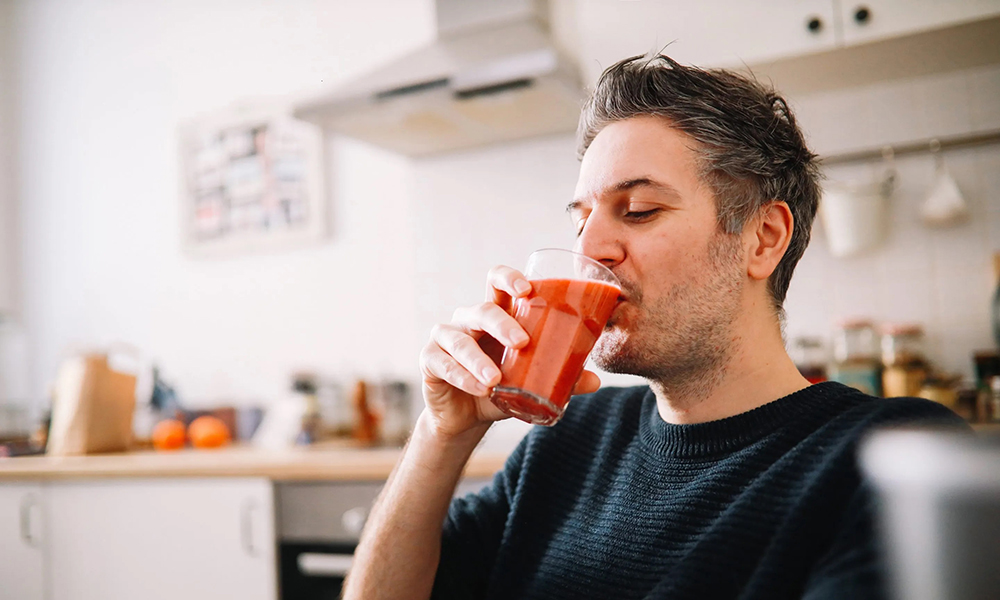
糖是敌人,对吗?事实并非总是如此——至少一项新研究表明,危害程度取决于你如何摄入糖分。
杨百翰大学(Brigham Young University)的研究人员在对来自多个大洲的超50万人的数据进行分析时,发现了意想不到的情况:通过苏打水等饮料摄入的糖分——甚至包括富含天然果糖的纯果汁——似乎比从食物中摄入的糖分危害更大。
该研究第一作者、杨百翰大学营养学教授凯伦·德拉·科尔特(Karen Della Corte)在一份新闻稿中表示:“这是第一项明确不同糖源与2型糖尿病风险间剂量反应关系的研究。这凸显了饮用含糖饮料——无论是苏打水还是果汁——比直接吃糖对健康的危害更大的原因。”
研究发现,从食物中摄入的糖分与糖尿病之间不存在此类关联,甚至在部分情形下,还呈现出与较低患病风险相关的态势。
在调整体重指数及各类生活方式风险因素后,研究结果包括:
• 含糖饮料有风险。每日每多摄入12盎司(约合355毫升)含糖饮料(包括软饮料、能量饮料和运动饮料),罹患2型糖尿病(T2D)的风险就会增加25%。
• 果汁同样存在问题。每日每多摄入8盎司(约合237毫升)果汁(包括100%纯果汁、花蜜和果汁饮料),罹患2型糖尿病的风险就会增加5%。
• 个体反应存在差异。研究人员指出,上述风险为“相对风险,而非绝对风险”,取决于个体患2型糖尿病的基线风险;例如,如果普通人患2型糖尿病的基线风险约为10%,那么每日饮用四罐苏打水可将这一风险提高到约20%,而非100%。
• 含糖食物则属于不同类别。相比之下,每日摄入20克(约1.6汤匙)总蔗糖(食糖)与总糖(饮食中所有天然糖和添加糖的总和)与2型糖尿病呈负相关,“暗示存在令人惊讶的保护性关联”。
为何饮用含糖饮料会更糟糕?
新闻稿解释称,这可能归结于其对新陈代谢产生的影响不同。
新闻稿指出:“含糖饮料和果汁提供的是游离糖,会导致血糖水平大幅上升,给肝脏代谢带来沉重负担并使其紊乱,进而增加肝脏脂肪含量并引发胰岛素抵抗。”
但在富含营养的食物(如全果、乳制品或全谷物)中摄入或添加的膳食糖不会导致肝脏代谢过载。新闻稿提到,“这些嵌入食物中的糖分因伴随纤维、脂肪、蛋白质和其他有益营养素,引发的血糖反应更为平缓。”
关于果汁的注意事项
尽管认为果汁与苏打水危害程度相近可能有悖直觉,但研究人员解释了其中的逻辑。
研究指出,与提供“空热量”的含糖饮料(SSBs)中的糖相比,果汁“可能含有维生素和植物化学物质等有益营养素;然而我们的研究发现,从果汁中摄入糖分与2型糖尿病风险呈正相关。果汁高糖且缺乏纤维的特性与含糖饮料类似,因此它无法替代全果——后者提供更高含量的纤维,有助于更好地调节血糖。”
不过,含糖饮料的危害仍高于含糖食物,因为它们提供的游离糖会导致血糖水平大幅上升。研究人员指出:“而其他来源的膳食糖,尤其是从全果、乳制品或全谷物等营养密集型食物中摄入时,可能因伴随纤维、脂肪或蛋白质,引发更为平缓的血糖反应。”
最后,他们指出,尽管未来仍需开展研究来评估糖分摄入的长期影响,但现有发现表明,糖分类型在决定膳食糖关联中至关重要,“显然,液体糖分摄入量越高,危害就越大。”(财富中文网)
译者:中慧言-王芳
糖是敌人,对吗?事实并非总是如此——至少一项新研究表明,危害程度取决于你如何摄入糖分。
杨百翰大学(Brigham Young University)的研究人员在对来自多个大洲的超50万人的数据进行分析时,发现了意想不到的情况:通过苏打水等饮料摄入的糖分——甚至包括富含天然果糖的纯果汁——似乎比从食物中摄入的糖分危害更大。
该研究第一作者、杨百翰大学营养学教授凯伦·德拉·科尔特(Karen Della Corte)在一份新闻稿中表示:“这是第一项明确不同糖源与2型糖尿病风险间剂量反应关系的研究。这凸显了饮用含糖饮料——无论是苏打水还是果汁——比直接吃糖对健康的危害更大的原因。”
研究发现,从食物中摄入的糖分与糖尿病之间不存在此类关联,甚至在部分情形下,还呈现出与较低患病风险相关的态势。
在调整体重指数及各类生活方式风险因素后,研究结果包括:
• 含糖饮料有风险。每日每多摄入12盎司(约合355毫升)含糖饮料(包括软饮料、能量饮料和运动饮料),罹患2型糖尿病(T2D)的风险就会增加25%。
• 果汁同样存在问题。每日每多摄入8盎司(约合237毫升)果汁(包括100%纯果汁、花蜜和果汁饮料),罹患2型糖尿病的风险就会增加5%。
• 个体反应存在差异。研究人员指出,上述风险为“相对风险,而非绝对风险”,取决于个体患2型糖尿病的基线风险;例如,如果普通人患2型糖尿病的基线风险约为10%,那么每日饮用四罐苏打水可将这一风险提高到约20%,而非100%。
• 含糖食物则属于不同类别。相比之下,每日摄入20克(约1.6汤匙)总蔗糖(食糖)与总糖(饮食中所有天然糖和添加糖的总和)与2型糖尿病呈负相关,“暗示存在令人惊讶的保护性关联”。
为何饮用含糖饮料会更糟糕?
新闻稿解释称,这可能归结于其对新陈代谢产生的影响不同。
新闻稿指出:“含糖饮料和果汁提供的是游离糖,会导致血糖水平大幅上升,给肝脏代谢带来沉重负担并使其紊乱,进而增加肝脏脂肪含量并引发胰岛素抵抗。”
但在富含营养的食物(如全果、乳制品或全谷物)中摄入或添加的膳食糖不会导致肝脏代谢过载。新闻稿提到,“这些嵌入食物中的糖分因伴随纤维、脂肪、蛋白质和其他有益营养素,引发的血糖反应更为平缓。”
关于果汁的注意事项
尽管认为果汁与苏打水危害程度相近可能有悖直觉,但研究人员解释了其中的逻辑。
研究指出,与提供“空热量”的含糖饮料(SSBs)中的糖相比,果汁“可能含有维生素和植物化学物质等有益营养素;然而我们的研究发现,从果汁中摄入糖分与2型糖尿病风险呈正相关。果汁高糖且缺乏纤维的特性与含糖饮料类似,因此它无法替代全果——后者提供更高含量的纤维,有助于更好地调节血糖。”
不过,含糖饮料的危害仍高于含糖食物,因为它们提供的游离糖会导致血糖水平大幅上升。研究人员指出:“而其他来源的膳食糖,尤其是从全果、乳制品或全谷物等营养密集型食物中摄入时,可能因伴随纤维、脂肪或蛋白质,引发更为平缓的血糖反应。”
最后,他们指出,尽管未来仍需开展研究来评估糖分摄入的长期影响,但现有发现表明,糖分类型在决定膳食糖关联中至关重要,“显然,液体糖分摄入量越高,危害就越大。”(财富中文网)
译者:中慧言-王芳
Sugar is the enemy. Right? Not always, as it turns out—at least according to a new study, which found it depends on how you consume it.
In analyzing data from over half a million people across multiple continents, researchers at Brigham Young University found something unexpected: that sugar consumed through drinks like soda—and even pure fruit juice, which is high in naturally occurring fructose—appeared to be more harmful than sugar that is eaten in foods.
“This is the first study to draw clear dose-response relationships between different sugar sources and Type 2 diabetes risk,” said Karen Della Corte, lead author and BYU nutritional science professor, in a news release. “It highlights why drinking your sugar—whether from soda or juice—is more problematic for health than eating it.”
Food sugar sources showed no such link and, in some cases, were even associated with a lower risk.
The findings, after correcting for body mass index and various lifestyle risk factors, include:
• Sugary drinks are risky. The risk for developing Type 2 diabetes (T2D) increased by 25% with each additional 12 oz daily serving of sugar-sweetened beverages—including soft drinks, energy drinks, and sports drinks.
• Fruit juice is also a problem. With each additional eight-ounce serving of fruit juice per day—including 100% fruit juice, nectars, and juice drinks—the risk for developing T2D increased by 5%.
• Individual responses may vary. The above risks are “relative but not absolute,” note the researchers, and depend on a person’s baseline risk of developing T2D; for example, if the average person’s baseline risk of developing T2D is about 10%, four sodas a day could raise that to roughly 20%, not 100%.
• Sugary food is in a different category. Comparatively, an intake of 20 grams a day (about 1.6 tablespoons) of total sucrose (table sugar) and total sugar (the sum of all naturally occurring and added sugars in the diet) showed an inverse association with T2D, “hinting at a surprising protective association.”
Why is drinking sugar worse?
It may come down to the differing metabolic effects, explains the news release.
“Sugar-sweetened beverages and fruit juice supply isolated sugars, leading to a greater glycemic impact that would overwhelm and disrupt liver metabolism thereby increasing liver fat and insulin resistance,” it notes.
But dietary sugars consumed in or added to nutrient-dense foods, such as whole fruits, dairy products, or whole grains, do not cause metabolic overload in the liver. “These embedded sugars,” says the release, “elicit slower blood glucose responses due to accompanying fiber, fats, proteins, and other beneficial nutrients.”
A note about fruit juice
While it might be counterintuitive to think that fruit juice could be in the same relative category of harm as soda, the researchers explain why it makes sense.
Compared to sugars from sugar-sweetened beverages (SSBs), which provide empty calories, fruit juice, the study says, “can contain beneficial nutrients such as vitamins and phytochemicals; however, our study found that sugar consumption from fruit juice was positively associated with T2D risk. The high sugar content and lack of fiber in fruit juice are similar to SSBs, making it a poor substitute for whole fruits, which provide higher fiber content to support better blood glucose regulation.”
But sugar-sweetened beverages are still worse than sugary foods, as they supply isolated sugars leading to a greater glycemic impact. “Whereas other sources of dietary sugars, particularly when consumed in nutrient-dense foods such as whole fruits, dairy products, or whole grains, may elicit slower blood glucose responses due to accompanying fiber, fats, or proteins,” the researchers note.
Finally, they point out that, while future research is still needed to evaluate the long-term impacts of sugar consumption, the findings suggest the importance of sugar type in determining the association of dietary sugar, “with higher liquid sugar intakes apparently linked to greater harm.”






